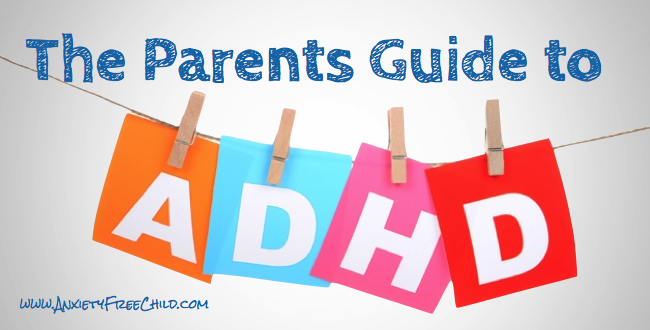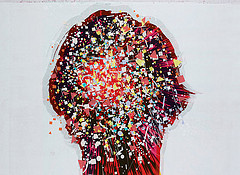 If your anxious child is hyperactive, has trouble concentrating and acts out impulsively, he or she must have ADHD, right?
If your anxious child is hyperactive, has trouble concentrating and acts out impulsively, he or she must have ADHD, right?
Not so fast.
Children may be hyperactive, inattentive or impulsive due to any number of reasons that have nothing to do with ADHD, or attention deficit hyperactivity disorder. Children may also be inattentive while being as quiet as a church mouse, hyperactive with a great ability to concentrate, or impulsive yet calm. All three examples could be children with ADHD.
In other words, the condition is tough to diagnose and may be even tougher to live with, for both the parent and the child, if it remains undiagnosed and left to run rampant. That much is known. Treatment options are also known, although there is no one-size-fits-all solution and there is no cure.
ADHD Symptoms
Other facts about ADHD noted by the National Institute of Mental Health (NIMH) include its rank as one of the most common childhood disorders and the three main categories of symptoms in produces. As you may have already guessed, those three main categories are hyperactivity, inattention and impulsivity.
 Hyperactivity is marked by:
Hyperactivity is marked by:
- Nonstop talking
- Compulsion to play with or touch everything in sight
- Dashing about, the need to be in constant motion
- Trouble sitting still, continuous fidgeting
- Problems performing quiet activities and tasks
Inattention is marked by:
- Problems concentrating or organizing
- Distraction
- Daydreaming
- Problems following instructions and processing information
- Quick and frequent boredom unless engaging in something enjoyable
- Scattered thoughts, inability to focus
- Appearance of not listening when being addressed
- Issues with losing things, completing homework, projects or assignments
Impulsivity is marked by:
- Extreme impatience
- Issues waiting for their turn
- Frequent interruptions, blurting out inappropriate comments
- Acting out without restraint or regard for consequences
Because many of these symptoms can crop up from conditions that range from emotional turmoil to a middle ear infection, a diagnosis of ADHD often includes a series of tests, observations and behavioral history of the child. In order to get an official ADHD diagnosis, NIMH says children must have exhibited symptoms for more than six months and the symptoms must be more intense than those found in other children of the same age group.
Adding one more layer of complication to the matter is the fact that ADHD can often coexist with other childhood conditions or illnesses. Anxiety is one of these conditions, as is depression, bipolar disorder and the uncommon yet still possible Tourette syndrome.
NIMH says others include a learning disability, oppositional defiant disorder and conduct disorder. Rebellion and stubbornness are marks of oppositional defiant disorder while conduct disorder includes behaviors such as bullying, stealing, lying and cheating.
What Causes ADHD?
 The exact cause of ADHD remains a mystery, although there are several theories kicking around. The predominant theory is that ADHD most likely develops from a combination of factors, with genetics at the top of the list.
The exact cause of ADHD remains a mystery, although there are several theories kicking around. The predominant theory is that ADHD most likely develops from a combination of factors, with genetics at the top of the list.
Genetics: Studies published in Biological Psychiatry and Current Psychiatry Reports back up the theory that ADHD can be passed down genetically – yet it’s unclear what genes are involved. An article in Archives of General Psychiatry additionally found that children carrying a specific version of a particular gene had thinner brain tissue in brain areas linked to attention. As the children got older, the brain tissue thickened to a normal level and their ADHD symptoms decreased.
Environment: Pregnant women who drink alcohol or smoke during pregnancy may have a higher risk of having a child with ADHD, according to studies published in the American Journal of Psychiatry and the Journal of the American Academy of Child and Adolescent Psychiatry. Children exposed to lead may also have a higher risk of developing the condition, a study in Environmental Health Perspectives says.
Brain injuries: Brain injuries do not necessarily cause ADHD, although children who suffer from brain injury may end up with symptoms that resemble those of ADHD, NIMH says. Only a very small portion of children with ADHD have a history of traumatic brain injury.
ADHD Myths
 Perhaps due to the lack of exact cause, variety of treatment options and difficulty of diagnosis, ADHD is surrounded by a number of myths that are simply not true.
Perhaps due to the lack of exact cause, variety of treatment options and difficulty of diagnosis, ADHD is surrounded by a number of myths that are simply not true.
Sugar causes ADHD. Research does not point to sugar as a cause of ADHD, or even necessarily a contributing factor. Studies have examined the effects of sugar versus sugar substitutes on children and have largely found no difference in behaviors. One study published in the Journal of Abnormal Child Psychology even got tricky about it.
Researchers rounded up children labeled as “sugar-sensitive” by their mothers and gave the children the artificial sweetener Nutrasweet. Half the mothers were told their children received sugar and the other half was told the truth. Moms who were told their children received sugar were more critical of their kids’ behavior and said they were more hyperactive than the other children, although both sets of kids received the same artificial sweetener.
Well, if not sugar, then things like red food coloring must cause ADHD. Artificial food colorings, preservatives and other additives do not cause ADHD per se, but research published in the Lancet says some additives may increase hyperactivity.
ADHD is a learning disability. Not true. ADHD is not a learning disability, although the symptoms of ADHD can make it difficult for children to pay attention, understand instructions or otherwise absorb information. Once those ADHD symptoms are quelled, learning can come much easier since there are no blockades in place preventing it.
Ritalin turns kids into robots. Ritalin may have as bad a rap as sugar when it comes to ADHD, but a report found children who take it are reaping benefits. A report out of King’s College London interviewed 151 children with ADHD in the U.S. and UK. Many children interviewed said Ritalin actually helped clear their minds so they could think better.
If my child sits quietly, works on whatever is in front of him and gets along with other kids, there’s no way he could have ADHD. Children who have the inattentive subtype of ADHD may look like they’re quietly working diligently, but they may not be paying attention to what’s in front of them. An ADHD diagnosis could be easily missed in such cases — and misdiagnosed in others. Children who constantly act up or lash out, for instance, may be thought to be suffering from emotional issues when they may be in fact suffering from the impulsive subtype of ADHD.
At least my child will outgrow ADHD, right? Maybe. While NIMH says most children do tend to grow out of ADHD, it is possible for people to suffer from the condition into their teens and even into adulthood.
ADHD Treatments
 The overall goal with any type of ADHD treatment is to alleviate the symptoms and improve a child’s overall ability to function. Ritalin and other medications are one treatment option, as are different types of psychotherapy, training and education, or a combination of any of the above.
The overall goal with any type of ADHD treatment is to alleviate the symptoms and improve a child’s overall ability to function. Ritalin and other medications are one treatment option, as are different types of psychotherapy, training and education, or a combination of any of the above.
Just as ADHD can show up in a variety of symptoms for any given child, any variety of treatments can be effective. Treatment effectiveness depends on each particular child, with pediatricians and mental health professionals often working in tandem to both diagnose the condition and create a treatment plan.
How Parents Can Help a Child Cope with ADHD
Understanding. Understanding ADHD is a major step parents can take to help their anxious child live successfully with the condition. Rather than scolding or berating a child when he or she isn’t able to instantly follow directions or calm down on cue, parents who understand the condition can come up with a more positive way to deal with the situation.
Positive feedback. One positive solution is a reward and consequence system, according to NIMH. Offering positive feedback and other rewards when your child exhibits behavior you want to encourage. Ignore or redirect behaviors you want to discourage. Continuously praising your child when it’s warranted can also help eradicate frustration and boost self-esteem.
Consistency, clarity and simplicity. Keeping consistent schedules, offering clear instructions and otherwise helping your child absorb information are other ways to help, NIMH says. Keeping things simple can mean giving one task at time instead of an overwhelming list or having your child invite over a single friend instead of an entire group.
Enjoyable activities. Engaging in relaxing and fun activities with your anxious child is another feel-good and do-good tip from NIMH. Make sure you make the activity even more relaxing and fun by pointing out instances of your child doing something well and applauding his or her abilities and strengths.
SOURCES:
- http://www.nimh.nih.gov/health/publications/attention-deficit-hyperactivity-disorder/complete-index.shtml
- http://www.forbes.com/sites/emilywillingham/2012/10/17/ritalin-doesnt-turn-adhd-children-into-robots/
Study info:
- Faraone SV, Perlis RH, Doyle AE, Smoller JW, Goralnick JJ, Holmgren MA, Sklar P. Molecular genetics of attention-deficit/hyperactivity disorder. Biological Psychiatry, 2005; 57:1313-1323.
- 3 Khan SA, Faraone SV. The genetics of attention-deficit/hyperactivity disorder: A literature review of 2005. Current Psychiatry Reports, 2006 Oct; 8:393-397.
- Shaw P, Gornick M, Lerch J, Addington A, Seal J, Greenstein D, Sharp W, Evans A, Giedd JN, Castellanos FX, Rapoport JL. Polymorphisms of the dopamine D4 receptor, clinical outcome and cortical structure in attention-deficit/hyperactivity disorder. Archives of General Psychiatry, 2007 Aug; 64(8):921-931.
- Hoover DW, Milich R. Effects of sugar ingestion expectancies on mother-child interaction.Journal of Abnormal Child Psychology, 1994; 22:501-515.
- McCann D, Barrett A, Cooper A, Crumpler D, Dalen L, Grimshaw K, Kitchin E, Lok E, Porteous L, Prince E, Sonuga-Barke E, Warner JO. Stevenson J. Food additives and hyperactive behaviour in 3-year-old and 8/9-year-old children in the community: a randomised, double-blinded, placebo-controlled trial. Lancet, 2007 Nov 3; 370(9598):1560-1567.
- Linnet KM, Dalsgaard S, Obel C, Wisborg K, Henriksen TB, Rodriguez A, Kotimaa A, Moilanen I, Thomsen PH, Olsen J, Jarvelin MR. Maternal lifestyle factors in pregnancy risk of attention-deficit/hyperactivity disorder and associated behaviors: review of the current evidence. American Journal of Psychiatry, 2003 Jun; 160(6):1028-1040.
- Mick E, Biederman J, Faraone SV, Sayer J, Kleinman S. Case-control study of attention-deficit hyperactivity disorder and maternal smoking, alcohol use, and drug use during pregnancy. Journal of the American Academy of Child and Adolescent Psychiatry, 2002 Apr; 41(4):378-385.
- Braun J, Kahn RS, Froehlich T, Auinger P, Lanphear BP. Exposures to environmental toxicants and attention-deficit/hyperactivity disorder in U.S. children. Environmental Health Perspectives, 2006 Dec; 114(12):1904-1909.
Photo Credits: leesean, IvanWalsh.com, Jason Hargrove, Jez Page





